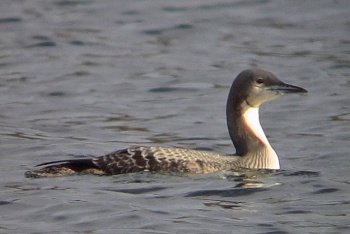(Replaced breeding plumage adult with clearer image.) |
(Spacing and dates.) |
||
| Line 4: | Line 4: | ||
;[[:Category:Gavia|Gavia]] pacifica | ;[[:Category:Gavia|Gavia]] pacifica | ||
==Identification== | ==Identification== | ||
| − | [[Image:269Diver 9bf.jpg|thumb|350px|right|Non-breeding<br />Photo © by {{user|Sandpiper|Sandpiper}}<br />Farnham, North [[Yorkshire]], [[UK]], February 2007 ]] | + | [[Image:269Diver 9bf.jpg|thumb|350px|right|Non-breeding<br />Photo © by {{user|Sandpiper|Sandpiper}}<br />Farnham, North [[Yorkshire]], [[UK]], 1 February 2007 ]] |
51–64·5 cm (20-25½ in), Wingspan 118cm<br /> | 51–64·5 cm (20-25½ in), Wingspan 118cm<br /> | ||
'''Adult breeding''': white-chequered black back and dove-grey head but paler nape area more extensive and throat patch has purple (not green) [[Dictionary G-L#I|iridescence]].<br /> | '''Adult breeding''': white-chequered black back and dove-grey head but paler nape area more extensive and throat patch has purple (not green) [[Dictionary G-L#I|iridescence]].<br /> | ||
| Line 12: | Line 12: | ||
==Distribution== | ==Distribution== | ||
| − | |||
Breeds in north-eastern Siberia and in northern [[North America]] from [[Alaska]] east to Hudson Bay. Winters off [[Japan]] and the Pacific coast of [[North America]] from Alaska to [[Baja California]] and commonly in the Gulf of [[California]]. May occur as a rare winter vagrant to the Atlantic coast but these birds may belong to [[Black-throated Diver]]. | Breeds in north-eastern Siberia and in northern [[North America]] from [[Alaska]] east to Hudson Bay. Winters off [[Japan]] and the Pacific coast of [[North America]] from Alaska to [[Baja California]] and commonly in the Gulf of [[California]]. May occur as a rare winter vagrant to the Atlantic coast but these birds may belong to [[Black-throated Diver]]. | ||
Accidental vagrant in the eastern [[United States]]. | Accidental vagrant in the eastern [[United States]]. | ||
==Taxonomy== | ==Taxonomy== | ||
| + | [[Image:234Pacific-Diver--9462.jpg|thumb|350px|right|Non-breeding<br />Photo © by {{user|Reader|Reader}}<br />Farnham, North [[Yorkshire]], 3 February 2007]] | ||
This is a [[Dictionary_M-O#M|monotypic]] species<sup>[[#References|[1]]]</sup>. | This is a [[Dictionary_M-O#M|monotypic]] species<sup>[[#References|[1]]]</sup>. | ||
Revision as of 08:19, 17 August 2019
Alternative name: Pacific Diver
- Gavia pacifica
Identification
51–64·5 cm (20-25½ in), Wingspan 118cm
Adult breeding: white-chequered black back and dove-grey head but paler nape area more extensive and throat patch has purple (not green) iridescence.
Adult non-breeding: dark-grey brown above clearly demarcated from white underparts (as in Arctic Loon/Black-throated Diver) but may lack conspicuous white flank patch seen on swimming birds.
Similar Species
Compared to the similar Arctic Loon/Black-throated Diver, Pacific Loon differs in its slightly smaller size, more rounded head, thinner bill, purple-glossed throat, narrower white stripes on neck sides, paler crown, and lack of a white flank patch.
Distribution
Breeds in north-eastern Siberia and in northern North America from Alaska east to Hudson Bay. Winters off Japan and the Pacific coast of North America from Alaska to Baja California and commonly in the Gulf of California. May occur as a rare winter vagrant to the Atlantic coast but these birds may belong to Black-throated Diver.
Accidental vagrant in the eastern United States.
Taxonomy
This is a monotypic species[1].
Habitat
Breeds on medium-large lakes and winters at sea.
Behaviour
Breeding
Breeds early-May to September (later in the north of their range).
It builds nests beside water often on an island or spit, a shallow scrape or sometimes a substantial mound of vegetation built in shallow water. It lays 2 eggs which are olive brown with black blotches. Both sexes incubate for approx 28 days.
The young feed themselves at 35 days and fly at 60 days.
Diet
Fish, also molluscs and crustaceans.
Vocalisation
Wailing, croaking and cackling calls.
References
- Clements, J. F., T. S. Schulenberg, M. J. Iliff, S. M. Billerman, T. A. Fredericks, B. L. Sullivan, and C. L. Wood. 2019. The eBird/Clements Checklist of Birds of the World: v2019. Downloaded from http://www.birds.cornell.edu/clementschecklist/download/
- Avibirds
- del Hoyo, J., Collar, N. & Garcia, E.F.J. (2019). Pacific Loon (Gavia pacifica). In: del Hoyo, J., Elliott, A., Sargatal, J., Christie, D.A. & de Juana, E. (eds.). Handbook of the Birds of the World Alive. Lynx Edicions, Barcelona. (retrieved from https://www.hbw.com/node/467260 on 17 August 2019).
- Russell, R. W. (2018). Pacific Loon (Gavia pacifica), version 1.2. In The Birds of North America (P. G. Rodewald, Editor). Cornell Lab of Ornithology, Ithaca, NY, USA. https://doi.org/10.2173/bna.pacloo.01.2
Recommended Citation
- BirdForum Opus contributors. (2025) Pacific Loon. In: BirdForum, the forum for wild birds and birding. Retrieved 30 April 2025 from https://www.birdforum.net/opus/Pacific_Loon






